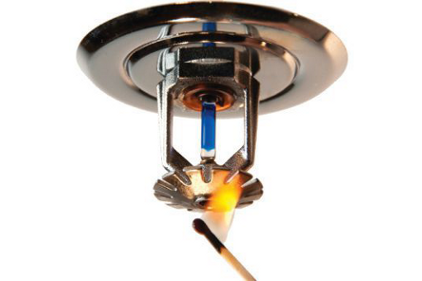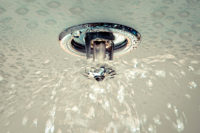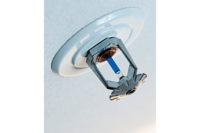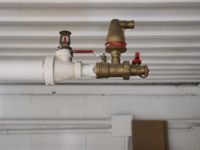Antifreeze solutions have been used for freeze protection in fire sprinkler systems for more than 60 years.
It was common practice for antifreeze solutions to be used in lieu of dry pipe systems where piping in small areas required freeze protection. Systems containing

|
antifreeze were typically auxiliary systems to wet pipe systems and were long recommended to be limited to a maximum of 40 gallons in capacity. For years, the use of antifreeze solutions was confined mainly to exterior overhangs such as loading docks, porte-cocheres and similar building features.
The use of antifreeze solutions has greatly expanded in recent years mostly because of the increase of sprinklered multistory residential occupancies such as those covered by NFPA 13R and single-family residences covered by NFPA 13D. This was mainly due to the lack of a residential sprinkler that was listed for use in a dry pipe system combined with the need for freeze protection of the piping in the unheated attic spaces of these buildings. There are literally thousands of buildings and single-family dwellings with sprinkler systems utilizing antifreeze solution.
The sprinkler installation standards (NFPA 13, 13R and 13D) provide the guidance for the use of antifreeze, and there was little change to the basic requirements until 2010. A fire incident occurred in August 2009 in an apartment located in Truckee, Calif., that raised concerns about the combustibility of antifreeze solutions in sprinkler systems. As a result, NFPA issued safety alerts concerning the use of antifreeze solutions. An alert dated July 6, 2010, recommended systems containing antifreeze used for protecting residential occupancies be drained and refilled with water. Further, on Aug. 18 of that year, NFPA banned the use of antifreeze for any new construction of residential occupancies.
Testing of antifreeze solutions was urgently conducted and the information learned resulted in the issuance of tentative interim amendments concerning antifreeze solutions issued for NFPA 13, 13D and 13R with an effective date of March 21, 2011.
For all new systems, solutions containing glycerin are limited to 48% by volume, and systems using propylene glycol are limited to 38%. The solutions must be factory premixed. This provides a protection level of -16° F for systems with glycerin and -3° F for glycol.
At the same time, a TIA was issued for NFPA 25 covering existing systems, which allows a 50% solution of glycerin and 40% for glycol. However, if for any reason a system must be drained or modified, the solutions cannot exceed the 48% or 38% thresholds. These requirements are not simply for dwelling units, but for all existing systems utilizing antifreeze solutions.
More research is needed
There are other requirements such as signage showing the percent of solution used, but the big issue facing the industry with these changes is the limited freeze protection (maximum of -16° F). Many areas in the United States and most of Canada require protection levels in excess of those provided with the new solution limitations.
However, the challenge does not end with residential systems. The initial testing centered on the issues affecting residential systems and/or dwelling units in commercial buildings. It was assumed that standard sprinklers used in commercial applications with their larger droplet sizes would produce better results regarding combustibility. Not so. A series of tests for nonresidential scenarios was recently conducted and the results were disconcerting. Ignition of the spray pattern occurred in four of 15 tests and in many of the 15 tests, substantial increases in fire heat release were recorded.
The result of all this is there is much more research that must be done. As the various NFPA technical committees address the issue, it is expected that there will be TIAs mandating a ban on all new systems containing antifreeze. If an outright ban is not declared, at the least there will be a severe reduction in the permitted solution, which will effectively negate the option of using antifreeze in all but a few locations where the ambient temperatures are fairly mild.
However, the bigger and tougher issue is dealing with the tens of thousands of existing systems using antifreeze solutions in some portion of the piping. NFPA technical committees are addressing the issue as this article goes to press with guidance needed before we go into next year’s cold season.
There are simply more questions than answers at this point, but one thing is clear. It would be unwise to specify the installation of a new sprinkler system allowing the option of antifreeze solutions for freeze protection.



